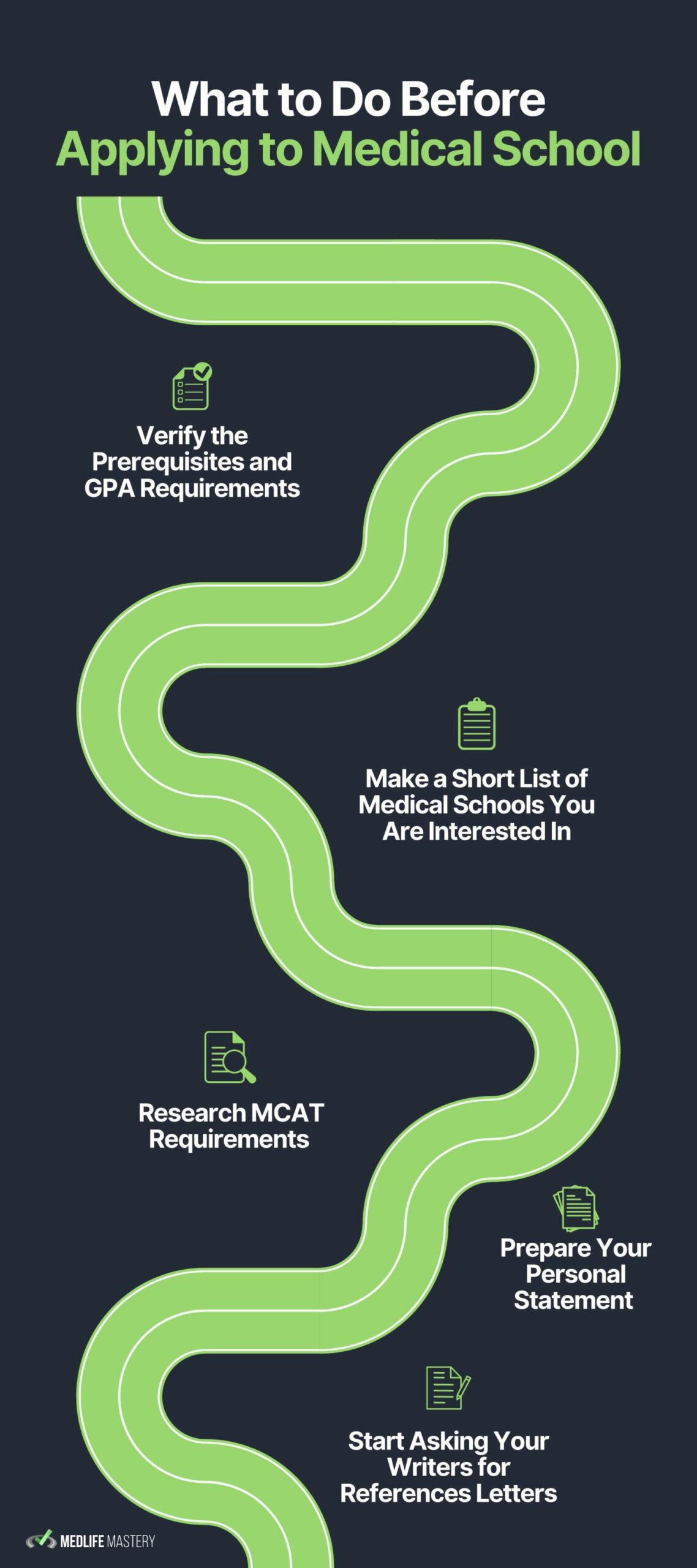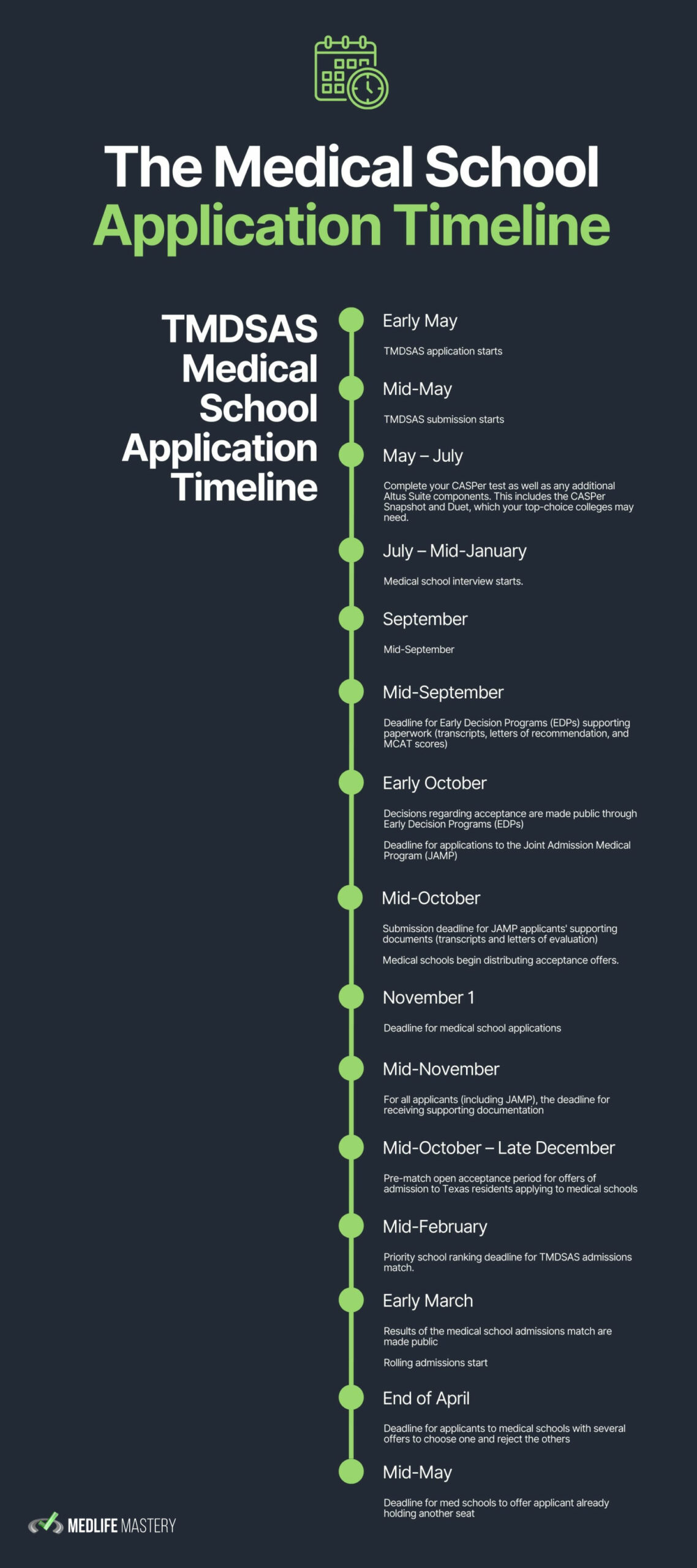The medical school application timeline is an essential piece of knowledge you should have before applying to medical schools.
You must know the precise deadlines for your application system. Thus, you will know what you can do to prepare, regardless of whether you apply through AMCAS, AACOMAS, TMDSAS, or any other portal.
You must confirm the exact dates for each application cycle because specific dates can change yearly. It takes almost a year to finish the application procedure for medical school. Excellent organization and preparation are therefore crucial.
This article will give you a thorough understanding of the medical school application timeline.
Regardless of the form of application you will be utilizing; we advise you to prepare for application season far in advance.
If you’re feeling any of these lately:
- Unsure when to actually submit your primary (and why everyone’s panicking about June 1st)
- Wondering how to juggle secondaries without losing your mind
- Confused about CASPer, letters, transcripts, and those sneaky deadlines
- Stressed about how expensive this whole process really is
- Or just overwhelmed by how LONG this journey takes…
You’re not alone.
We’ve all been there – including Mollie, one of our MedLife mentors, who’s now living proof that surviving this process lands you exactly where you want to be (in med school) 🎉
You can watch her video here or read this article breaking down the ideal med school application timeline (AMCAS + AACOMAS).
Think of it as your roadmap to avoid the classic mistakes that delay apps, drain your energy, or worse, cost you interview invites.
Timing is everything in this game, and Mollie’s got you covered with:
✅ When to actually submit primaries
✅ How to prep secondaries before they flood your inbox
✅ Key dates for interviews, decisions, and those tricky “Plan to Enroll” deadlines
✅ Pro tips to stay organized (and sane) through it all
If you’re applying this cycle (or even next year), this is a must-watch to stay ahead of the curve.
What to Do Before Applying to Medical School
Planning ahead can help your applications go faster because you will have plenty of time to schedule standardized examinations and collect letters of recommendation.
As applications open and deadlines start to loom, you can also seek professional advice before the big push.
Here is what we advise doing in the months before application season.

1. Verify the Prerequisites and GPA Requirements
Learn about the GPA requirements for medical school to get a sense of what you should strive for.
To develop a successful improvement strategy if your grades are suffering, read up on how to get into medical school with a low GPA.
If you are still determining if your present academic performance will be sufficient to achieve the basic standards at some schools, you may also look at the easiest medical schools to get into.
Make sure you meet your preferred colleges' requirements by learning about the prerequisites for medical school.
Additionally, learn about the essential extracurriculars for medical school to add depth and appeal to your medical school application.2. Make a Short List of Medical Schools You Are Interested In
Learn how to select the best medical school for you using MSAR.
Do not apply to only one medical school, so you have options if you are not accepted.
Additionally, it would help if you learned the acceptance rates for medical schools. Some medical schools are easier to get into than others.
Based on your GPA, narrow your options to medical schools if you are more likely to be admitted.
3. Research MCAT Requirements
Although most medical schools do, some do not require the MCAT. Find out when to take the MCAT and look up the exam dates to find the most convenient.
Research what a decent MCAT score is and when to start your MCAT preparation. Furthermore, before you start your MCAT preparation, make a plan for your studies and take a diagnostic exam.4. Prepare Your Personal Statement
A personal statement is required for the majority of medical schools. Start developing ideas for your personal statement, and ask professionals for advice on making it as strong as possible.
Examine sample personal statements for medical schools that worked. This includes AMCAS, AACOMAS, and TMDSAS sample personal statements.5. Start Asking Your Writers for References Letters
Select the best writers and verifiers for your reference letters. It would help if you started asking professors or other potential writers for a medical school reference letter. This can be done in person or by mail.
Meet to discuss the letter's content and bring examples of the work you completed for each professor's course(s).
Additionally, be ready to suggest some attributes you hope each letter-writer would address in their evaluation.
Give your letter writers any information or materials they might need for their writing. This includes details on the program(s) you are applying to, your academic records, career goals, and anything else they might require.
The Medical School Application Process
Although all medical schools have a similar fundamental application procedure, how each evaluates applicants differs significantly.
The following information will help you stay on track when you submit your primary and secondary medical school applications.

Primary Application
You will first submit a single application, typically using one of three centralized online application services:
Your primary application gives medical schools enough details to conduct a preliminary applicant screening.
Your transcripts (undergraduate transcripts plus any graduate or post-baccalaureate transcripts) are part of a completed primary application.
Information from your most significant experiences (academic, research, clinical, and extracurricular activities), your MCAT scores, letters of recommendation, and a brief personal statement.
Each medical school independently determines the last day for applicants to submit their materials through the application service. However, our medical school admission specialists advise you to submit your application as soon as possible, regardless of these deadlines.
Early cycle applications get assessed first and so have a better probability of getting accepted at almost all schools.

Preparing for Primary Application Submission
Don’t wait for the June deadline to start preparing your primary application. To make sure everything runs smoothly, you’ll need to start early – like months early.
1. Start Drafting Your Personal Statement Early
Your personal statement is arguably one of the most important parts of your application. It’s your chance to stand out from the crowd, so don’t rush it. Start brainstorming ideas as early as the winter or spring before the application opens.
Ask trusted people for feedback. Friends, family, or mentors can provide honest insights to help refine your story.
Make sure it reflects who you are. Authenticity goes a long way here. Admissions committees read thousands of these, so it’s important to be yourself, not who you think they want you to be.
2. Work on Your Work and Activities Section
This section may not seem like a big deal, but it takes longer than you expect. You’ll need to categorize and describe everything from shadowing experiences to volunteer work, and it all needs to tie back to why you’ll make a great doctor. Get started on this as early as the spring before application season.
3. Letters of Recommendation: Don’t Wait
Asking for letters of recommendation can be tricky. Give your recommenders at least a month to write their letters, but ask well before that. You don’t want to be scrambling at the last minute. If your school provides a committee letter, make sure everything is coordinated with them.
Pro tip: Send gentle reminders as the deadline approaches. A kind nudge can ensure they send it in on time without being pushy.
4. Transcripts: Get Them Sent Early
Many students forget this step, but it’s super important. Request your transcripts as early as possible.
Sometimes, services like Parchment take longer than expected to deliver your transcripts, and this can delay your verification process. Some schools still use snail mail for transcripts, so don’t procrastinate.
Secondary Application
The admissions committees at your medical schools will evaluate your AMCAS file and either accept you or send you a secondary application.
Some colleges send secondary applications to every candidate. Others undergo a first selection process typically determined by GPA and MCAT results.
You must fill out and submit each secondary application as soon as you receive it unless you have already decided not to apply to that school. The majority of medical schools will reject any late applications.
Secondary applications often consist of a range of essays on given subjects. For example, you can be asked to talk about your favorite book, describe a leadership position you have held, or provide specifics on your best academic performance.
Additional Reading:
You would be required to do so if you did not submit your letters of reference through AMCAS.
You can call the school and ask for a fee waiver if the expense of returning secondaries is prohibitive.
For instance, you might be qualified for a waiver from a particular institution if you were granted one by AMCAS.

Navigating Secondary Applications
Secondary applications are the next hurdle after your primary gets verified. They typically start rolling in within a few days, but here’s where things get a bit tricky: not all secondaries are created equal.
How to Tackle Secondaries Without Losing Your Mind
Some schools send secondaries automatically, while others screen primary applications first. You might be required to submit your secondaries within two weeks of receiving them, while others are more flexible.
Prioritize your secondaries. Make a list of your target schools and start with those first. Pay special attention to deadlines, especially for schools with rolling admissions.
Time management is key. Balancing multiple secondaries can be overwhelming, but you’ll need to stay organized. Set clear goals for each day or week so you’re not cramming everything at once.
For more tips on secondary applications, check out this video on handling multiple secondaries efficiently: How to Become a Strong Applicant.
Secondaries are More Than Just Essays
Each secondary application comes with its own set of essay prompts. While you might be tempted to copy and paste answers, don’t do it. Med schools can tell when you’re reusing material, and it’s a major turn-off. Instead, take the time to tailor your responses to each school.
What to include: Why you want to go to that specific school, what makes you a great fit, and how you align with their mission.
What to avoid: Generic responses. Schools want to know why you’re passionate about attending their institution, not just any med school.
Interviews
The committee will decide whether to reject your secondary medical school application, invite you to the campus for an interview, or postpone your application until after the preliminary interview round.
After the medical school interview, decisions are typically made in writing.
Policies and formats for medical school interviews differ. For example, you may have a one-on-one interview at some schools while having a panel interview at others.
The interview is yet another chance to impress medical schools! Use this collection of common medical school interview questions as practice.The Medical School Application Timeline
Due to the rolling admissions policies of most medical schools, staying on track is crucial.
Applications are reviewed as they come in under rolling admissions. Therefore, your acceptance chances may rise if you apply early in the cycle.
Many schools start conducting interviews in August or September. However, some MD schools (and even DO schools) announce acceptances as early as mid-October.
There's a chance that getting into the class will get more challenging as spaces fill up.
For your reference, here is the medical school application timeline for AMCAS, AACOMAS, and TMDSAS (as of April 2023).What Happens After Your Application
Now, this is where things get tough: after you submit your secondaries, you wait. And wait. And wait some more. It’s one of the most nerve-wracking parts of the entire process, but don’t panic.
When Will You Hear Back About Interviews?
Interview invites start rolling out between August and March. During this time, you’ll need to be quick on your feet and respond to invites ASAP. Many schools operate on a rolling admissions basis, meaning the earlier you interview, the better your chances.
Quick responses matter. Schedule your interviews as soon as you can—slots fill up fast!
No news isn’t necessarily bad news. Some schools take their time. If you’re not hearing back, consider sending a letter of interest to let them know you’re still excited about the program.
Rolling vs. Non-Rolling Admissions: What’s the Difference?
Not all schools operate on the same timeline. Rolling admissions schools accept students on a rolling basis, which means spots can fill up fast. Non-rolling schools, on the other hand, will wait until they’ve reviewed all applicants before making decisions.
Rolling admission schools: Start giving decisions as early as October and continue throughout the year.
Non-rolling schools: Often release decisions all at once, usually later in the spring.

The Final Step: Choosing Your Medical School
Once you’ve gone through interviews and (hopefully) received multiple offers, it’s time to make the big decision. This is where AMCAS’s “Plan to Enroll” and “Commit to Enroll” options come into play.
What Is "Plan to Enroll" and How Does It Work?
In February, you’ll gain access to the Plan to Enroll tool on the AMCAS website. This allows you to narrow down your acceptances to your top three schools. You don’t have to make your final choice until later in the spring when you use the Commit to Enroll feature to choose your one and only med school.
Pro tip: Keep track of the deadlines for each school. You don’t want to miss out on your dream school because of a technicality.Don’t Forget About Waitlists!
If you’re waitlisted, there’s still hope! As other students finalize their decisions, spots on the waitlist open up, and you could be next in line. If you’re in this situation, keep in touch with the schools to express your continued interest.
Why Submitting Your Application Early Makes All the Difference
Both AMCAS and AACOMAS applications open in early June. However, getting your application verified takes time—sometimes up to two months.
During verification, the AAMC cross-references your self-reported grades with your official transcripts. You won’t be considered for secondaries or interviews until that’s complete.
Here’s the kicker: Med schools don’t wait around. The sooner your application is verified, the sooner it’s sent to schools, giving you a head start on the review process.
Submit early, like June 10, if possible. The earlier your application gets verified, the earlier it’ll land in front of the admission committee.
AMCAS Medical School Application Timeline

Early May
May – February
Take the CASPer test and prepare for additional Altus Suite requirements your school may have. Find the exact dates for the CASPer test if any of your schools require it. As soon as you realize you must take a CASPer test, starting your test preparation would help.
Late May – Early June
Since information needs to be confirmed, you should submit your application as soon as possible. The more you wait, the longer it will take for the schools to receive it.
Technically, you have until the end of July to submit your application, but doing so severely lowers your chances. Try to submit your application by July 1 at the latest. However, even this is not ideal. Because US medical schools employ rolling admissions, individuals who apply initially will be given priority. If openings remain after the initial round, more invites will be sent.Late June
You must take the MCAT by the third week of May for your scores to be made public by this date. This ensures that your application is included in this batch.
August – October
Medical school secondary essays contain questions the institution would like you to respond to. They will understand you more as a candidate and person and your priorities, experiences, and values.
Despite the various prompts, adversity essays for medical schools and secondary essays on diversity are particularly well-liked.
Some institutions send secondary applications to all applicants, while others send them to those who pass the initial screening.
Check each school's deadlines and the guidelines included with the request for a secondary application because they differ between institutions.
For example, some may state that you have two weeks from receiving the secondary essays or application to finish them and submit them.
September – February
It would help if you started preparing for your medical school interview as soon as possible. Learn how to respond to typical medical school interview questions like "Tell me about yourself" and "Why do you want to be a doctor?"
Seek advice from your academic advisors and professional consultants. They can assist you with your interview preparation so that you may receive helpful feedback on both your answers and presentation.
Remember that a lot of medical schools will take letters of intent.
After the interview, if you do not hear back from your top-choice school for several weeks, you can decide to write them a medical school letter of intent with an update on your application. This might improve your chances of getting accepted!
TMDSAS Medical School Application Timeline

Early May
Get ready for your Dual Degree MD/Ph.D. essay (if applicable), your TMDSAS employment and activities, personal statement, personal characteristics essay, and an optional essay.
Mid-May
May – July
July – Mid-January
September
Mid-September
Early October
JAMP is a unique initiative created to support Texas students who are both highly talented and economically underprivileged in pursuing a medical degree.
Mid-October
November 1
All components of the application must be finished. This also includes paying fees.
In addition to receiving a refund, the application will not be processed if payments are submitted after the cutoff. Extensions are not given.
Mid-November
Documents mailed must have a postmark from this day. Remember that some colleges will not extend interview invitations until all necessary paperwork has been submitted. Therefore, it is advised to make sure they arrive as quickly as possible.
Mid-October – Late December
Mid-February
Early March
End of April
Mid-May
AACOMAS Medical School Application Timeline
Osteopathic medical schools lack the same level of organization as AMCAS-affiliated institutions. The application round typically begins in May and ends in April of the following year, but specific dates differ by school.
The general DO school application timetables are listed below. First, however, you must confirm the precise dates for each cycle and the prerequisites of each medical school.

Early May
Mid-June
Early August
October – April
End of October
Early December
Early January
Early February
Deadline for applications for the following medical schools:
Mid-February
Late February
Early March
Deadline for applications for the following medical schools:
Mid-March
Deadline for applications for the following medical schools:
Early April
Deadline for applications for the following medical schools:
Note: These deadlines are ONLY for the College of Osteopathic Medicine in the mentioned medical schools and NOT for any other programs they offer.
Additional FAQs – Understanding the Medical School Application Timeline
When Should I Start My Med School Application?
Submission of AMCAS applications does not start until the first week of June. Therefore, you will have roughly one month to finish your application before submission.
You will start the application process in the spring to begin medical school in the fall of the following year.
How Long Does It Take To Hear Back From Med School Application?
However, this may vary from school to school. Therefore, you should call or email the medical school you have applied to or visit their website occasionally to make sure.
When Can I Submit My AMCAS Application 2023?
Do All Medical Schools Have the Same Application Timeline?
For instance, primary application dates will be comparable for medical schools using AMCAS. However, the critical component application dates will be the same for schools using TMDSAS.
However, remember that each school will likely have its deadlines for secondary applications.
